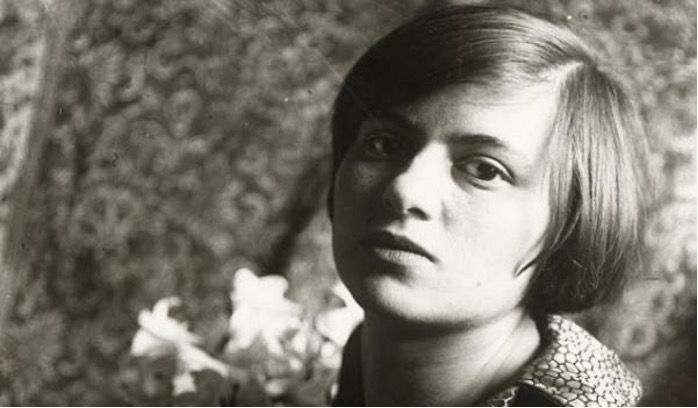Biography
Marianne Liebe was born in Chemnitz, Germany, in 1893, and started her painting and sculpture studies in 1911, in the Superior School of Fine Arts in Weimar, Germany, at the age of 18. In 1912, she was transferred to the Grand Ducal College of Art, also in Weimar. Her first works were mostly expressionist portraits, exhibited for the first time in 1918 at the Galerie Gerstenberger in Chemnitz. She married the Norwegian painter Erik Brandt a year later and they came back to Weimar in 1921.
In this first period of her professional career, Marianne mostly painted until she joined the Bauhaus. It was a school that was only operational for 14 years, between 1919 and 1933, as it was closed by the Nazi regime. Over 1250 students from 29 different countries studied at the Bauhaus. There, they designed metal ashtrays, ceramic cups, tapestries, stained glass windows, lamps, wooden and steel furniture, architectural buildings, etc., all with the spirit of the modern movement that they belonged to. These contributions still influence everyday objects today; we do not realise it, but some of them are in our homes.
Out of those nearly 1300 students, only 24 women graduated. Marianne was among them: she graduated in metallurgy. Most women graduated in textile, since they were all sent to the weaving workshop after the initiation course. Many of them did not settle and made their way through the architecture, metallurgy, photography or carpentry workshops, among others. They stood out in many art and design areas in the school: typography, photography, metallurgy, carpentry, architecture, glass making, painting, ceramics, furniture design, interior design, industrial design, etc.
There were other women students that, for one reason or another, had to quit their studies; but, while they were there, they produced outstanding contributions, which proved that they fully understood the Bauhaus principles.
Marianne enrolled in the Bauhaus in 1924 and studied with the Hungarian artists László Moholy-Nagy. He advised her to study industrial design in the metal workshop of the school, a department that at that moment only accepted men.
Marianne had a functionalist approach to her work, which was revolutionary at the time. The clean, simple lines of her pieces showed the modernist influence of her mentor. Although she created a surprising amount of everyday objects, including ashtrays, teapots (in particular the iconic teapot No. MT 49, 1924), and coffee sets, her lamp designs were particularly outstanding.
Marianne Brandt-Liebe also worked in the photography workshop at the Bauhaus, taking pictures from unusual angles, specially self-portraits, and disorienting and distorting reflections on metal and glass surfaces. Little by little, she earned the respect of everyone for her special way of representing the products she designed; besides, they were in line with the prevailing trends at the Bauhaus, such as the so-called "carrot shapes" and the frequent use of triangles, cylinders and spheres.
In 1926, she left the Bauhaus with her husband to spend nine months in Paris. During that gap year, she started experimenting with photomontage, creating carefully composed collages with pictures and texts that she cut out of printed media. Although they are not as popular, she made around 45 photomontages in a decade. Her works show the influence of Moholy-Nagy's experiments in photography, and of Hannah Höch, her contemporary, famous for her sarcastic and satirical photomontages.
Marianne's photomontages often reflected the role of the "New Woman", liberated and independent women who lived in the main cities in Europe. Parisian Impressions (1926), for instance, a cheerful collage of personalities and scenes in the city, depicts a series of women in different states of undress.
Marianne came back to the Bauhaus and ended up working as director of the metal workshop (1928-1929), but she quit when it merged with other departments. During those years, she also devoted more time to photography and photomontage and participated in the emblematic exposition “Film und Foto” in Stuttgart in 1929.
After graduating from the Bauhaus in 1929, she started working in furniture production and in some interior design projects at the Berlin studio of the architect and Bauhaus founder Walter Gropius. Later that same year, she became head of the design department at the Ruppelwerk hardware factory in Gotha, Germany, where she would stay until 1932.
The rise of National Socialism was a dire time for Marianne, who could not secure a job as an industrial engineer. She joined the Reichskulturkammer, a Nazi organisation of artists in 1939 because she needed to, not because she wanted to. She remained there until her financial problems forced her to move back with her parents in 1933. She had been separated from her husband since 1926, and she filed for divorce in 1935.
The years that Marianne Brandt-Liebe spent with her family between 1933 and 1945 separated her from the art world. Although she continued painting and creating art, she never managed to repair this breach.
After the war, Marianne made a living as a teacher for many years in Dresden and Berlin. In the 1970s, she moved to the German Democratic Republic and became a photographer again after her youth. She immortalised women in the interwar period and their role in the Bauhaus.
Marianne Liebe was a pioneer in using photography to capture still lives. She also took some beautiful self-portraits with innovative, different approaches to her own image. She spent many years working as an independent artist, teaching applied arts and design in Berlin and Dresden between 1949 and 1954. She spent her last decades as a painter, weaver and sculptor in Chemnitz.
Marianne died in Kirchberg, Germany, at the age of 89.
